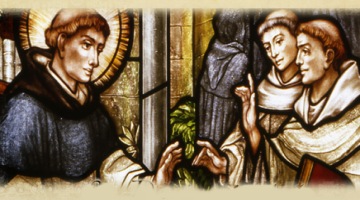 Saint Dominic (Spanish: Santo Domingo), also known as Dominic of Osma and Dominic of Caleruega, often called Dominic de Guzmán and Domingo Félix de Guzmán (1170 – August 6, 1221), was a Spanish priest and founder of the Dominican Order. Dominic is the patron saint of astronomers.
Saint Dominic (Spanish: Santo Domingo), also known as Dominic of Osma and Dominic of Caleruega, often called Dominic de Guzmán and Domingo Félix de Guzmán (1170 – August 6, 1221), was a Spanish priest and founder of the Dominican Order. Dominic is the patron saint of astronomers.
Dominic was born in Caleruega, halfway between Osma and Aranda de Duero in Old Castile, Spain. He was named after Saint Dominic of Silos, who is said to be the patron saint of hopeful mothers. The Benedictine abbey of Santo Domingo de Silos lies a few miles north of Caleruega.
In this painting depicted the Virgin giving the rosary to Saint Dominic. In the scene also appear Fray Pedro de Santa María Ulloa, Saint Catherine of Siena and Servant of God, Mary of Jesus de León y Delgado. The fresco is located in the Church of Santo Domingo in San Cristóbal de La Laguna (Tenerife, Spain).
In the earliest narrative source, by Jordan of Saxony, Dominic’s parents are named Felix Guzman and Juanna of Aza. The story is told that before his birth his barren mother made a pilgrimage to the Abbey at Silos, and dreamed that a dog leapt from her womb carrying a torch in its mouth, and “seemed to set the earth on fire”. This story drew resonance from the fact that his order became known, after his name, as the Dominican order, Dominicanus in Latin which a play on words interpreted as Domini canis: “Dog of the Lord.” Jordan adds that Dominic was brought up by his parents and a maternal uncle who was an archbishop. The failure to name his parents is not unusual, since Jordan wrote a history of the Order’s early years, rather than a biography of Dominic. A later source, still of the 13th century, gives their names as Juana and Felix. Nearly a century after Dominic’s birth, a local author asserted that Dominic’s father was “vir venerabilis et dives in populo suo” (“an honoured and wealthy man in his village”). The travel narrative of Pero Tafur, written circa 1439 (about a pilgrimage to Dominic’s tomb in Italy), states that Dominic’s father belonged to the family de Guzmán, and that his mother belonged to the Aça or Aza family. Dominic’s mother, Jane of Aza, was beatified by Pope Leo XII in 1828.
Education and early career
Dominic was educated in the schools of Palencia (they became a university soon afterwards) where he devoted six years to the arts and four to theology. In 1191, when Spain was desolated by famine,young Dominic gave away his money and sold his clothes, furniture and even precious manuscripts to feed the hungry. Dominic reportedly told his astonished fellow students, “Would you have me study off these dead skins, when men are dying of hunger?” In 1194, around age twenty-five, Dominic joined the Canons Regular in the canonry of Osma, following the rule of Saint Benedict.
In 1203 or 1204 he accompanied Diego de Acebo, the Bishop of Osma, on a diplomatic mission for Alfonso VIII, King of Castile, to secure a bride in Denmark for crown prince Ferdinand. The envoys traveled to Denmark via Aragon and the south of France. The marriage negotiations ended successfully, but the princess died before leaving for Castile.
In the south of France, Dominic and Diego de Acebo began a program to convert the Cathars, a Christian religious sect with gnostic and dualistic beliefs, which the Roman Catholic Church deemed heretical; as part of this, Catholic-Cathar public debates were held at Verfeil, Servian, Pamiers, Montréal and elsewhere. Dominic concluded that only preachers who displayed real sanctity, humility and asceticism could win over convinced Cathar believers; the institutional Church as a general rule did not possess these spiritual warrants.However, even Dominic managed only a few converts among the Cathari.
More detail here
https://en.wikipedia.org/wiki/Saint_Dominic
